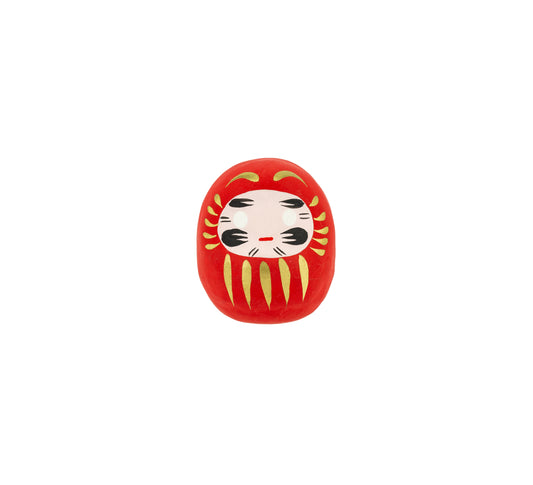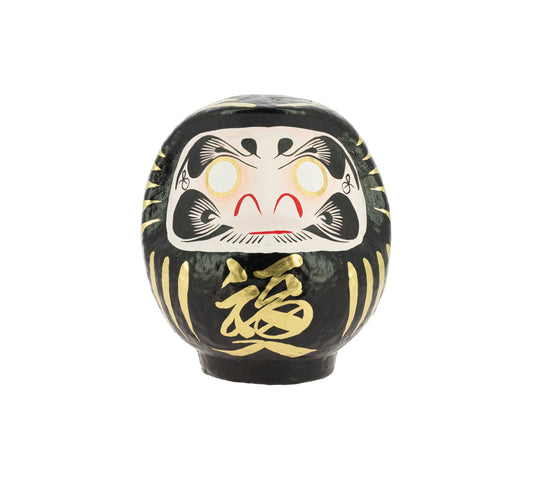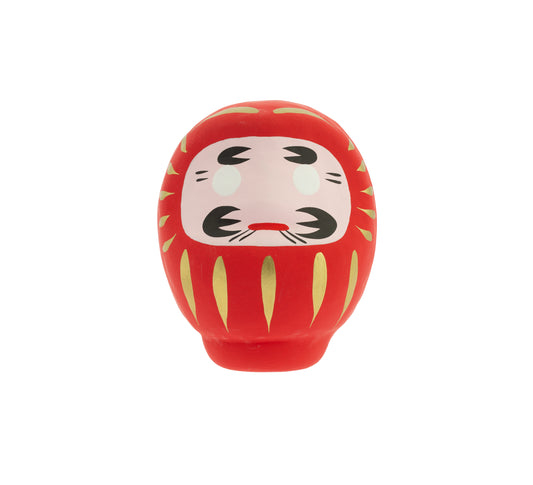
Daruma: History, Symbolism and Tradition
The Daruma is a Japanese amulet with a wide symbolism and history in Japan. Daruma is the Japanese adaptation of Bodhidharma, a monk who introduced Zen Buddhism in China.
This iconic doll has deep historical and spiritual significance, as well as being a symbol of perseverance, good luck and cultural tradition in Japan.

Origin and history of the Daruma
Bodhidharma was an Indian or Persian monk known for his fundamental role in the spread of Zen Buddhism. It is believed that Bodhidharma arrived in China around 520, settling in the Shao-lin monastery, where he developed practices that would later inspire Shaolin Kung Fu.
It is said that Bodhidharma attained enlightenment after meditating uninterruptedly for nine years, a period known as "nine years staring at the wall". He had to face fatigue and sleep and it is said that, in a moment of great frustration, he cut off his eyelids to stay awake. It is also said that, due to atrophy, his arms and legs fell off, yet he was able to remain upright at all times, anchored firmly on his axis.
The representations of Daruma
Being the founder of Zen, Bodhidharma, or Daruma, is a very popular figure in Japan and a recurring theme in art. His physical features, so exotic for an Oriental, and the anecdotes of his legend make his representations easily recognizable.
He is found in numerous paintings and sculptures not only in temples, but also in the homes of the Japanese. It appears printed on fabrics, papers, in calligraphy, engravings, toys, jewelry or even key chains.

However, the best known representation is the Daruma doll made of paper mache, also called the doll of the goals. It is a good luck charm and now we detail its characteristics.
The rich symbolism of the Daruma doll
The Japanese Daruma has its origins in talismans that were prepared for parishioners at the Daruma-dera, the Daruma temple located in the city of Takasaki north of Tokyo. Around 1770, the first molds of Daruma dolls were probably made so that people could make their own amulets. It was not until the 19th century that its popularity grew and it gradually spread throughout Japan.
Its Shape: Knowing the history of Bodhidharma, it is perfectly understandable its peculiar round shape and the importance of its eyes.
The eyes:White when buying a doll, they are large and symmetrical. They serve as a reminder to strive to achieve what we have set out to do.
Facial Hair:The eyebrows of the Japanese Daruma are usually crane-shaped and the hair on the cheeks is reminiscent of a turtle's shell, these two animals being symbols of longevity for the Japanese. These shapes are usually best seen on larger figures such as our special Daruma.
Like a teeter-totter:The Daruma doll is conflated with the tradition of Okiagari-Koboshi, traditional Japanese teething toys. Its shape lends itself to the fact that when it falls down, it can be picked up again, a symbol of perseverance.

The meaning of colors
The most prominent are the following:
- Red Daruma: this is the best known and most traditional of the Darumas. It is used for all kinds of purposes.
- White Daruma: associated with purity, it is used for love affairs.
- Golden Daruma: the color of abundance, it is used for purposes related to money, good fortune and prosperity.
- Violet Daruma: used for purposes related to longevity. Integrate healthy habits, achieve inner peace and live in harmony.
- Yellow Daruma: used to achieve prosperity in finances. It can also be used to work on protection and security issues.
- Pink Daruma: used for goals related to romantic love, affection in relationships and happiness.
- Turquoise Daruma: used for success in your exams and also all kinds of personal challenges.
Darumas are made in all sizes, from the size of an egg to the size of a person. You can check on our website all the available models.
How to proceed with the Japanese Daruma?
"Daruma, Daruma: I make a purpose and paint you an eye. When I have fulfilled it, I will paint the other one".
It is a small ritual that invites us to realize what we long for and that requires our effort to make it come true.
- We choose a purpose and paint an eye on our Daruma.
- Work towards your goal: The Daruma acts as a constant reminder to keep you focused.
- When we have achieved it, we can paint the other eye as a sign of gratitude.
As a way of learning, we can also write down how we have achieved our goal, feeling at that moment a great personal satisfaction.
In Japan, each painted Daruma is valid for one year. Therefore, around January 18, the annual burning of Darumas is organized in many temples. People bring to the bonfires the figures they have used during the year, expressing their gratitude.

The spirit of the Daruma
Its figure serves as a reminder that, with determination and perseverance, we will achieve the purpose we have set for ourselves. In this sense, it is very important that we choose a specific and attainable goal. It is not about buying a Daruma and then waiting for our wish to magically come true: Daruma motivates us to work hard and apply ourselves.
What to do if we don't achieve our resolution for the year? That's okay. Let us remember that Bodhidharma took nine years to attain enlightenment and did not give up in the first year, nor in the eighth year. Therefore, we will burn our Daruma with gratitude for the journey we have made and find new means to reach our goal.
Peculiarities of the Japanese Daruma
The Daruma doll has its annual festival in the city of Takasaki. It is held every year on January 6 and 7. Tens of thousands of Japanese people come to buy new lucky dolls for the coming year.
Japanese politicians also resort to these figures in order to win elections - even the Prime Minister paints an eye on a giant Daruma to succeed!
A meaningful gift
Giving a Daruma as a gift is a gesture full of optimism and good wishes. It is ideal for celebrations such as New Year, birthdays or any occasion that marks a new beginning. In addition, its versatility in sizes and designs makes it a perfect gift for people of all ages.
Explore our available Daruma models and find the one that best suits your goals! If you have any questions or want to share your experience, don't hesitate to contact us. We will be happy to help you.
Sources:
Buddhist dictionary / Héctor V. Morel and José Dali Moral / Ed. Kier, Buenos Aires, 1989.
Dictionary of Oriental Wisdom / AAVV / Ed. Paidós, Barcelona, 1993.
https://es.wikipedia.org/wiki/Daruma





